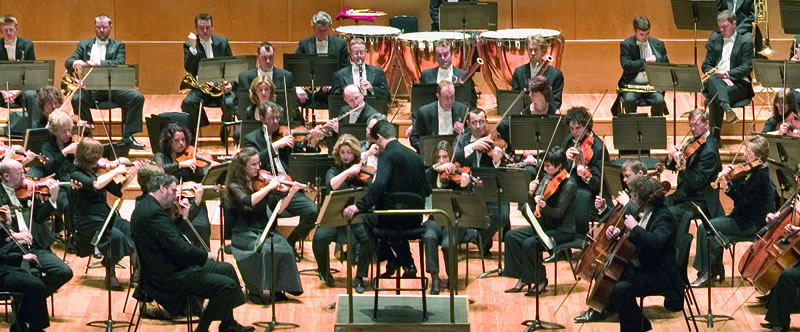England’s Philharmonia OrchestraPleasures of Music
The Orchestra
By Anonymous
(Note: The orchestra dates back to the 6th Century B.C. in Ancient Greece, although no musical instruments were involved --the orchestra denoted a large semicircular space for dancing in Attic, or Greek, theater. In Roman times the orchestra area became the location for stage effects and was even flooded for theatrical sea battles--the idea of a “pit” area in front of the stage defined the orchestra at this time, and of course still exists in opera houses and theaters today. Pre-dating the Greek theater, China’s outrageous Emperor Hu (the Tiger) is recorded to have had a 500-piece all-girl orchestra in 200 A.D.; the Indian gamelan orchestra seems to have originated around the 2nd Century B.B. as an all-percussion aggregation. The history of the orchestra as we know it today is largely bound up with the history of Western Greco-Roman civilization. And as long as there have been orchestras by any name, so has there been lively debate as to the proper makeup of the orchestra as music and instrumentation changed over time. At the turn of the 20th Century at least one publication, The Musician, campaigned vigorously in print for the orchestra to embrace new instruments and expanded lineups. This anonymous editorial from the April 1900 issue makes the case for what was then a modernist point of view about the makeup of the symphonic orchestra.)
It is mere folly to talk as the professors talk of a standard orchestra. There never has been a perfect orchestra; there is not a perfect orchestra yet; there is not likely to be a perfect orchestra for many years to come; and instead of regretting that we are moving away from the orchestra of Mozart’s and Haydn’s time, we should rejoice on that very account. Why two flutes should be right and three flutes shameful extravagance; why the double clarinet should be looked upon as an unauthorized interloper; why the tubas should be thought the inferiors of the trombones merely because they came in later--these and a hundred other things pass the comprehension of everyone who gives ten minutes of serious thought to the orchestra.
Leonard Bernstein, Vienna, 1985, conducts the Wiener Philharmoniker in the ending of Act 3 of Wagner’s Die Walküre. Thomas Stewart is Wotan.The truth is that instead of repelling all the new instruments we should welcome them, welcome them as helping to make the orchestra a genuine instrument. It is time to be done with the art of faking, which is the only art explained in any book of instrumentation yet written; it is time to say that as there are plenty of players available and we are no longer living around the courts of petty three-square-mile princelets, we should have a complete orchestra. And a complete orchestra would include a complete flute group--a treble, alto, tenor, and bass flute; the complete oboe group that the best bands have at present…and so on right through the orchestra. One of the most important things would be to complete the string group. We want a true tenor, running down to the G beneath the tenor C; the violins would then play a true alto part in their best register. We want also the six-stringed double bass with frets, to avoid the present sudden disappearance of the bass part. When these things are done we shall be on the way to getting an orchestra worth writing for.
Engineers Orchestra of Bucharest performs Ravel’s Pavane pour une infante defunte (Pavane for a Dead Princess), in Bucharest, November 21,2010, with Andrei Iliescu conducting.
Founder/Publisher/Editor: David McGee
Contributing Editors: Billy Altman, Laura Fissinger, Christopher Hill, Derk Richardson
Logo Design: John Mendelsohn (www.johnmendelsohn.com)
Website Design: Kieran McGee (www.kieranmcgee.com)
Staff Photographers: Audrey Harrod (Louisville, KY; www.flickr.com/audreyharrod), Alicia Zappier (New York)
E-mail: thebluegrassspecial@gmail.com
Mailing Address: David McGee, 201 W. 85 St.—5B, New York, NY 10024



